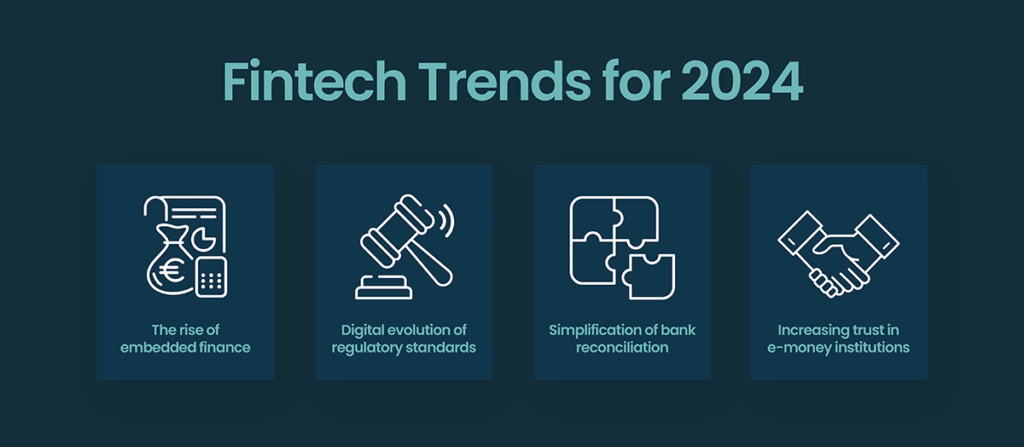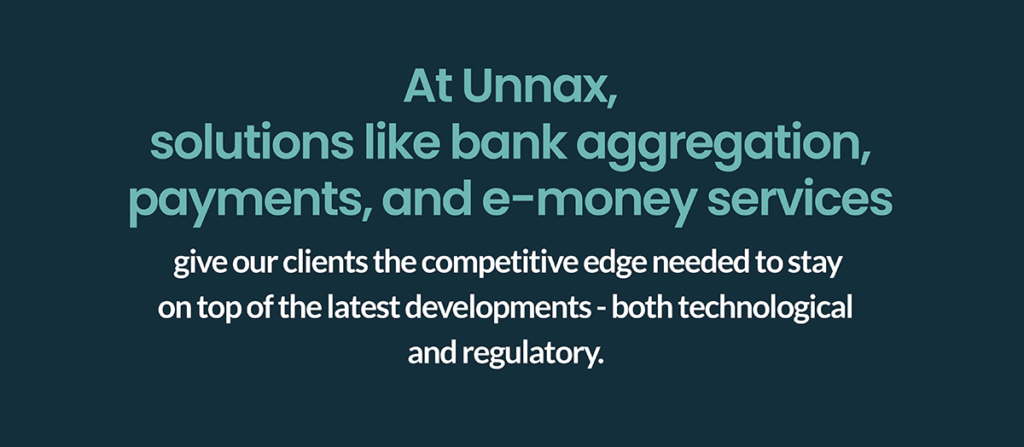Over the past year, the fintech industry has witnessed tremendous growth.
As of 2023, the global fintech market reached a value of more than $226B (USD). From 2024 to 2032, the market is projected to grow annually by 16.8%, reaching a value of more than $917B.
Financial technologies only continue to evolve, with more and more businesses around the world recognizing the importance of strong fintech partnerships.
To ensure your company is prepared for the next fintech wave, we have compiled the four top fintech trends to know for 2024:

1. The rise of embedded finance
As consumers look for more personal and convenient financial services, embedded finance rises as the top fintech trend to watch in 2024.
Between 2023 and 2028, the global embedded finance market is expected to grow annually by an incredible 35.5%. Retail and e-commerce are set to be the biggest segments within the embedded finance market, with this growth propelled by increased startup investments and greater smartphone penetration.
Embedded finance and BaaS (Banking-as-a-Service) as a whole eliminate the need for traditional financial intermediaries.
By doing so, embedded finance providers redefine how people and businesses interact with money, enabling direct integrations with various platforms and applications. As a result, APIs have a major role to play in enabling both financial and non-financial brands to integrate financial services directly into their websites, platforms, and mobile apps.
Embedded finance seamlessly integrates financial services into non-financial platforms, enabling businesses to offer enhanced services and consumers to access financial products without leaving their preferred platforms. Consumers benefit from convenience and personalized experiences, while businesses enjoy new monetization opportunities and improved support for expanding their operations.
Additionally, in 2024, we are likely to see embedded finance emerge as a key service for enhancing overall customer loyalty. Ensuring customers have the freedom and flexibility to engage with embedded finance solutions will be essential to establishing a successful business model.
👉 Read more: Discover the hottest Payment trends f0r 2024
2. Evolution of regulatory standards
Regulators worldwide are working diligently to address the modern risks of digital finance. As the regulatory approach to fintech continues to evolve, fintechs and other financial service providers must adapt quickly and confidently to keep up with new regulatory standards.
If you are operating in Europe, some of the top regulatory developments to watch include the Markets in Crypto-Assets Regulation (MiCA), Payment Services Directive v3.0 (PSD3), the European Commission’s eIDAS Regulation, and the European standards for eInvoicing.
Businesses operating in Spain should also pay close attention to the evolution of lending rules coming into effect in 2026, as adaptations to these can revolutionize how companies deliver new financial services. This comes on top of the new “Crece y Crea” regulation in Spain, which makes electronic invoicing mandatory in the country in 2026 as well.
👉 Read more: Everything about mandatory Electronic Invoicing in Spain
3. Simplification of bank reconciliation
For small businesses, fintech plays a pivotal role in managing financial and banking challenges.
Efficient bank reconciliation often stands out as one of the critical needs of businesses. With the help of APIs, bank reconciliations can be greatly simplified through automation, enabling businesses to easily integrate various APIs with their accounting systems.
Plus, API-enabled automation can improve a company’s financial accuracy and reduce the overall time and resources spent on manual reconciliation processes.
4. Increasing regulatory attention in e-money institutions
The European Commission defines electronic money institutions (e-money or EMIs for short) as legal entities authorized to issue e-money. The broad definition encompasses many different fintechs, making it necessary for fintech companies to navigate evolving e-money regulations strategically.
Specifically, fintechs need to pay special attention to regulatory developments in data privacy, cybersecurity, and financial services in 2024.
The overlap of technology with finance makes this a particularly complex challenge, as companies must ensure they are safeguarded both physically and digitally. Yet, the solution to keeping up with e-money institutions — and, as a result, increasing public trust in EMIs — is to invest in adaptable technology capable of swiftly responding to the latest regulatory changes.
Moreover, for fintechs not prepared to meet the EMI requirements, collaborations with compliant EMIs will emerge as an ideal solution. Through such partnerships, fintechs can facilitate more streamlined compliance strategies and prepare for future regulatory developments in the dynamic fintech landscape.

Innovate with Unnax in 2024
In 2024, Unnax, as a licensed Electronic Money Institution and financial technology leader, holds the key to enabling embedded finance and Open Finance at your business.
Solutions like bank aggregation, payments, and e-money services give our clients the competitive edge needed to stay on top of the latest developments — both technological and regulatory.
Start the new year right with Unnax’s embedded finance solutions.










